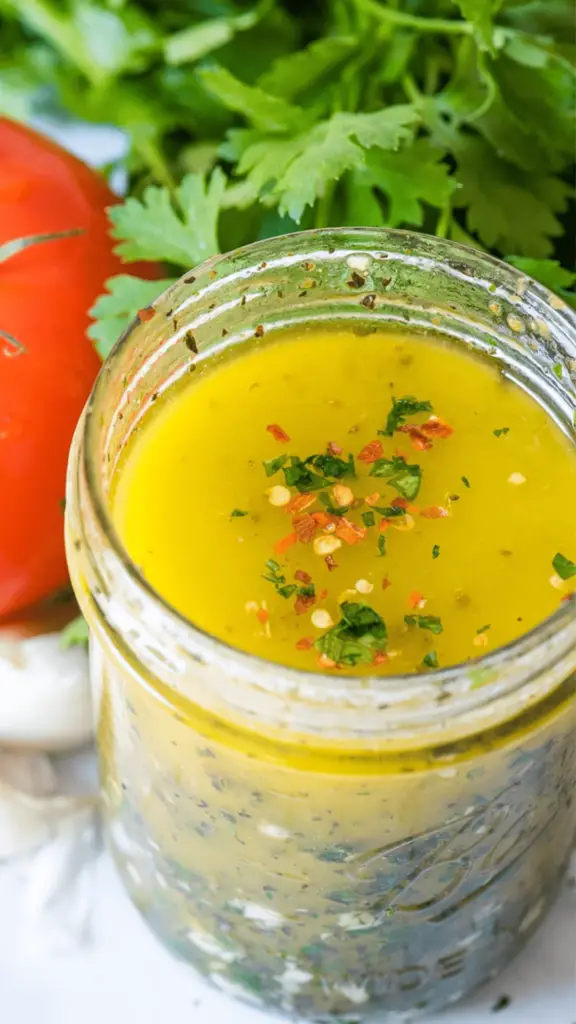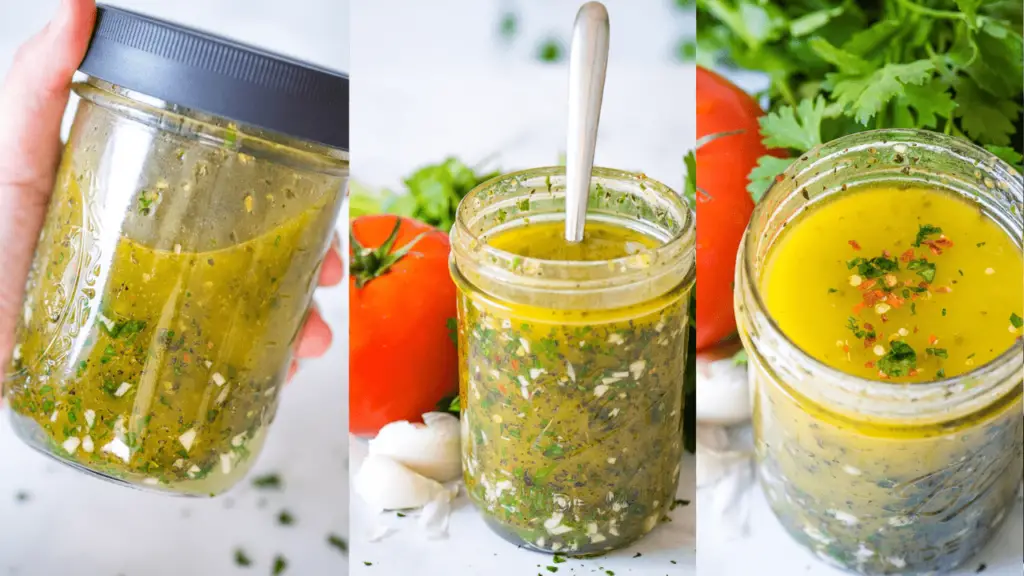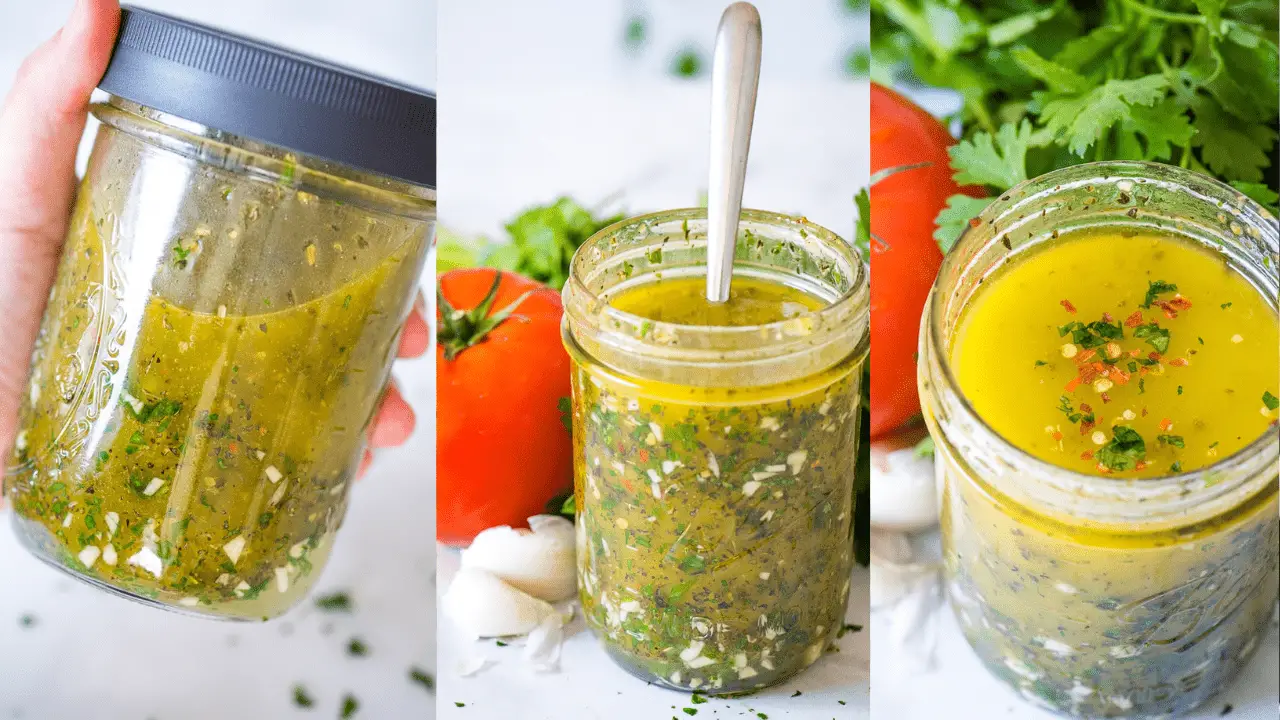If you’re a pasta enthusiast seeking to elevate your salad game, look no further than homemade dressings. These versatile concoctions can transform a simple bowl of noodles into a flavor-packed masterpiece. As a professional cook, I’m thrilled to share my expertise in crafting delectable pasta salad dressings that will tantalize your taste buds and leave your guests craving for more.

Ingredients
- 3/4 cup extra virgin olive oil (or your preferred oil)
- 1/4 cup vinegar (red wine, white wine, apple cider, or balsamic)
- 2 tablespoons Dijon or whole-grain mustard
- 1 tablespoon minced garlic (or 1 teaspoon garlic powder)
- 1 tablespoon dried herbs (Italian seasoning, basil, oregano, or your favorite blend)
- 1/2 teaspoon salt (or to taste)
- 1/4 teaspoon freshly ground black pepper (or to taste)
- 1 tablespoon honey or maple syrup (optional, for a touch of sweetness)
Timing
- Preparation Time: 5 minutes
- Cooking Time: N/A
- Total Time: 5 minutes
Step-by-Step Guide to Making Homemade Pasta Salad Dressing
Gather Your Ingredients: Assemble all the necessary components from the list above, ensuring you have fresh herbs and high-quality vinegar on hand.
Prepare the Base: In a jar or bowl, combine the oil and vinegar of your choice. This dynamic duo forms the foundation of your dressing, providing a perfect balance of richness and tanginess.
Add the Aromatics: Mince the garlic (or use garlic powder if you prefer) and incorporate it into the oil-vinegar mixture. This step infuses your dressing with a delightful aroma and depth of flavor.
Introduce the Herbs and Spices: Sprinkle in the dried herbs, salt, and freshly ground black pepper. Italian seasoning, basil, and oregano are classic choices, but feel free to experiment with your favorite herb blends.
Emulsify and Adjust: If using Dijon or whole-grain mustard, whisk it into the mixture. This step helps emulsify the dressing, ensuring a smooth and cohesive texture. Taste and adjust the seasoning to your liking, adding a touch of honey or maple syrup if you prefer a hint of sweetness.
Shake or Whisk: If using a jar, secure the lid and give it a vigorous shake until the ingredients are well combined. Alternatively, whisk the dressing vigorously in a bowl until it’s thoroughly emulsified.
Dress and Enjoy: Pour the freshly made dressing over your pasta salad and toss gently to coat every noodle and vegetable evenly. Alternatively, you can serve the dressing on the side, allowing your guests to drizzle it over their portions to their desired level of indulgence.

Creamy vs. Vinaigrette: Choosing the Right Dressing for Your Pasta Salad
When it comes to pasta salad dressings, you have two main choices: creamy or vinaigrette. Each option offers distinct flavors and textures, catering to different palates and preferences.
Creamy Dressings
Creamy dressings, such as ranch, blue cheese, or a tangy mayonnaise-based concoction, provide a rich and velvety coating for your pasta salad. These dressings are ideal for those who prefer a more indulgent and decadent experience. To create a creamy dressing, simply substitute the oil in your base recipe with mayonnaise, sour cream, or Greek yogurt. You can also incorporate ingredients like cream cheese, Parmesan, or crumbled feta for an extra burst of flavor.
Vinaigrette Dressings
On the other hand, vinaigrette dressings offer a refreshing and tangy alternative. These dressings are typically made with a combination of oil and vinegar (or lemon juice), along with herbs, spices, and other flavorful additions. Vinaigrettes are perfect for those who prefer a lighter and more vibrant dressing that allows the natural flavors of the pasta salad ingredients to shine through. Experiment with different vinegar varieties, such as red wine, white wine, balsamic, or apple cider, to create unique and delightful vinaigrettes.
Ultimately, the choice between creamy or vinaigrette dressings comes down to personal preference and the overall flavor profile you desire for your pasta salad. Don’t be afraid to try both options and find the perfect match for your taste buds.
Tips for Balancing Flavors in Pasta Salad Dressing
While the basic ingredients for pasta salad dressings are relatively straightforward, achieving the perfect balance of flavors is an art form. Here are some tips to help you create harmonious and well-rounded dressings:
Play with Acidity: Vinegar or lemon juice provides the tanginess that cuts through the richness of the oil and adds brightness to your dressing. Adjust the amount of acid to your liking, keeping in mind that a little goes a long way.
Embrace Sweetness: A touch of sweetness can help balance out the acidity and round out the flavors. Honey, maple syrup, or even a pinch of sugar can work wonders in creating a well-balanced dressing.
Experiment with Fats: While olive oil is a classic choice, don’t be afraid to explore other oil varieties, such as avocado, grapeseed, or even nut oils, to add depth and complexity to your dressings.
Season with Intention: Salt and pepper are essential for enhancing flavors, but don’t stop there. Experiment with different spice blends, such as Italian seasoning, ranch seasoning, or even a touch of smoked paprika or cumin, to add layers of complexity.
Incorporate Umami: Ingredients like Parmesan cheese, Worcestershire sauce, or even a splash of soy sauce can introduce an umami (savory) flavor profile, adding depth and richness to your dressing.
Remember, balancing flavors is an iterative process, so don’t be afraid to taste and adjust as you go. The key is to find the perfect harmony between tanginess, sweetness, saltiness, and richness, creating a dressing that complements and elevates the flavors of your pasta salad.
Adding Herbs and Spices to Enhance Your Pasta Salad Dressing
One of the joys of making homemade pasta salad dressings is the ability to infuse them with fresh and vibrant flavors from herbs and spices. These aromatic ingredients can take your dressings from ordinary to extraordinary, adding depth and complexity to every bite.
Fresh Herbs
Fresh herbs are a game-changer when it comes to pasta salad dressings. Consider incorporating the following:
- Basil: With its sweet and slightly peppery notes, basil adds a refreshing touch to vinaigrettes and complements tomato-based pasta salads beautifully.
- Parsley: A versatile herb that brings a bright and herbaceous flavor to any dressing, parsley is a classic addition to Italian-inspired dressings.
- Dill: Pair dill with creamy dressings for a delightful tang and a hint of freshness, perfect for pasta salads with seafood or cucumber.
- Cilantro: If you’re a fan of bold flavors, cilantro can add a vibrant and slightly citrusy note to your dressings, complementing Latin-inspired pasta salads.
Dried Herbs and Spices
While fresh herbs are always a treat, dried herbs and spices offer convenience and longevity. Here are some flavorful options to consider:
- Italian Seasoning: A blend of dried herbs like basil, oregano, and rosemary, Italian seasoning is a versatile addition to vinaigrettes and creamy dressings alike.
- Garlic Powder: A staple in many dressings, garlic powder adds depth and savory notes without the hassle of mincing fresh garlic.
- Paprika: A sprinkle of smoked or regular paprika can lend a subtle warmth and earthiness to your dressings.
- Cumin: For a touch of exotic flavor, cumin can add a unique dimension to your pasta salad dressings, especially when paired with Mexican or Middle Eastern-inspired ingredients.
Remember, when using dried herbs and spices, a little goes a long way. Start with small amounts and adjust to your taste preferences. Don’t be afraid to experiment and create your own unique blends to complement the flavors of your pasta salad.
Healthy Alternatives for Pasta Salad Dressing
While pasta salad dressings can be indulgent, there are plenty of ways to make them healthier without sacrificing flavor. Here are some simple swaps and alternatives to consider:
Swap Oils: Instead of using traditional olive or vegetable oils, opt for healthier alternatives like avocado oil, grapeseed oil, or even walnut oil. These options are rich in heart-healthy monounsaturated and polyunsaturated fats.
Use Greek Yogurt or Skyr: For creamy dressings, substitute mayonnaise or sour cream with plain Greek yogurt or skyr. These dairy products are packed with protein and offer a tangy flavor while reducing the overall calorie and fat content.
Incorporate Nut Butters: For a creamy and nutty twist, try adding a small amount of nut butter, such as almond or peanut butter, to your dressings. This addition adds richness, protein, and healthy fats.
Embrace Vinegar Varieties: Experiment with different vinegar varieties like apple cider vinegar, balsamic vinegar, or rice vinegar. These options can provide a tangy kick while offering additional health benefits.
Add Fresh or Dried Fruit: Incorporating fresh or dried fruits like berries, citrus zest, or dried cranberries can add natural sweetness and depth of flavor without the need for excessive amounts of sugar or honey.
Boost with Herbs and Spices: Fresh herbs and spices not only add flavor but also provide antioxidants and other beneficial compounds. Don’t be shy about loading up your dressings with these nutrient-rich ingredients.
Remember, moderation is key when it comes to enjoying pasta salad dressings. By making simple substitutions and incorporating healthier ingredients, you can indulge in flavorful dressings without compromising your dietary goals.
How to Store and Preserve Homemade Pasta Salad Dressing
One of the best things about homemade pasta salad dressings is their versatility and ability to be stored for later use. With a few simple tips, you can ensure that your dressings stay fresh and flavorful for days or even weeks.
Refrigerator Storage
Most pasta salad dressings can be stored in an airtight container or jar in the refrigerator for up to one week. However, there are a few exceptions:
- Dressings containing fresh herbs or garlic may have a shorter shelf life, lasting only 3-4 days in the refrigerator.
- Creamy dressings made with mayonnaise or dairy products should be consumed within 3-4 days for optimal freshness and food safety.
To extend the shelf life of your dressings, consider storing the oil-based components separately from the vinegar or acidic components. This prevents the vinegar from breaking down the oil over time, resulting in a separated and unappetizing dressing.
Freezer Storage
If you’ve made a large batch of pasta salad dressing or want to preserve it for an extended period, freezing is an excellent option. Here’s how to do it:
Portion the Dressing: Divide the dressing into smaller portions, using airtight containers or freezer-safe bags. This allows you to thaw only the amount you need at a time.
Leave Headspace: When using containers, leave a small amount of headspace to allow for expansion during freezing.
Label and Date: Clearly label the containers or bags with the dressing type and date of preparation.
Freeze Immediately: Place the portioned dressings in the freezer as soon as possible to maintain freshness.
Most pasta salad dressings can be frozen for up to 3 months. When ready to use, thaw the dressing in the refrigerator overnight, and give it a good shake or whisk before serving.
Pairing Different Dressings with Various Pasta Salad Ingredients
The beauty of pasta salads lies in their versatility, allowing you to combine a wide range of ingredients to create a harmonious and flavorful dish. However, not all dressings pair equally well with every pasta salad ingredient. Here are some guidelines to help you match the perfect dressing with your chosen ingredients:
Vinaigrette Dressings
Vinaigrette dressings, with their tangy and bright flavors, pair beautifully with the following pasta salad ingredients:
- Fresh vegetables: Tomatoes, cucumbers, bell peppers, and leafy greens like arugula or spinach.
- Herbs: Fresh basil, parsley, dill, or cilantro.
- Proteins: Grilled chicken, shrimp, or tuna.
- Cheeses: Feta, goat cheese, or Parmesan.
Creamy Dressings
Creamy dressings, such as ranch, blue cheese, or mayonnaise-based dressings, complement the following pasta salad ingredients:
- Hearty vegetables: Broccoli, cauliflower, carrots, or roasted vegetables.
- Proteins: Bacon, ham, or grilled chicken.
- Cheeses: Cheddar, Swiss, or blue cheese.
- Nuts or seeds: Walnuts, pecans, or sunflower seeds.
Fruit-Based Dressings
If you’re feeling adventurous, consider incorporating fruit-based dressings into your pasta salad repertoire. These dressings pair beautifully with ingredients like:
- Fresh fruits: Strawberries, mango, or grapes.
- Nuts or seeds: Almonds, pecans, or pumpkin seeds.
- Proteins: Grilled chicken or shrimp.
- Cheeses: Feta or goat cheese.
Remember, these are just guidelines, and the beauty of homemade dressings lies in their versatility. Don’t be afraid to experiment and find your own unique flavor combinations that suit your taste preferences.
Nutritional Facts
While the nutritional values of pasta salad dressings can vary depending on the specific ingredients and quantities used, here’s an approximate breakdown of the nutritional information for a serving (2 tablespoons) of a classic vinaigrette dressing:
- Calories: 150
- Total Fat: 16g
- Saturated Fat: 2g
- Cholesterol: 0mg
- Sodium: 150mg
- Total Carbohydrates: 1g
- Dietary Fiber: 0g
- Sugars: 1g
- Protein: 0g
It’s important to note that these values are approximate and can fluctuate based on the specific ingredients and quantities used in your homemade dressing. Additionally, if you opt for a creamy dressing or incorporate additional ingredients like cheese or nuts, the nutritional profile may differ significantly.
Conclusion
Crafting homemade pasta salad dressings is a delightful culinary adventure that allows you to unleash your creativity and tailor flavors to your personal preferences. By mastering the art of balancing tanginess, richness, and herbaceous notes, you can elevate your pasta salads from ordinary to extraordinary.
Remember, the key to a successful pasta salad dressing lies in using high-quality ingredients, experimenting with different flavor combinations and embracing your own unique culinary style. Don’t be afraid to step out of your comfort zone and try new ingredients or techniques – that’s where the magic happens!
As you embark on this flavorful journey, keep in mind that homemade dressings not only elevate your pasta salads but also offer a healthier and more cost-effective alternative to store-bought options. With a little practice and experimentation, you’ll soon find yourself creating dressings that perfectly complement your favorite pasta salad ingredients, leaving your guests in awe and craving for more.
So, go ahead, roll up your sleeves, and let your culinary creativity shine through. Whether you’re hosting a backyard barbecue, a potluck gathering, or simply indulging in a delightful meal at home, your homemade pasta salad dressings will undoubtedly steal the show. Bon appétit!
FAQs
Can I use different types of vinegar in my pasta salad dressings?
Absolutely! Experimenting with various vinegar varieties is a great way to add depth and complexity to your dressings. Red wine vinegar, white wine vinegar, balsamic vinegar, and apple cider vinegar are all excellent options to consider. Each type of vinegar offers a unique flavor profile that can complement different pasta salad ingredients.
How can I make my pasta salad dressing thicker or thinner?
If you prefer a thicker dressing, you can try adding a small amount of mayonnaise, Greek yogurt, or even a touch of Dijon mustard. These ingredients will help emulsify the dressing and create a richer, creamier texture. On the other hand, if you want a thinner dressing, simply increase the amount of vinegar or lemon juice in the recipe.
Can I use fresh herbs instead of dried herbs in my pasta salad dressing?
Absolutely! Fresh herbs can add a burst of vibrant flavor to your dressings. However, keep in mind that fresh herbs have a shorter shelf life, so it’s best to use the dressing within a few days if you incorporate them. Additionally, you may need to adjust the quantities, as fresh herbs tend to be more potent than their dried counterparts.
How long can I store homemade pasta salad dressing in the refrigerator?
The shelf life of homemade pasta salad dressings can vary depending on the ingredients used. Generally, dressings made with vinegar, oil, and dried herbs can last up to one week in the refrigerator. Dressings containing fresh herbs or dairy products may have a shorter shelf life of 3-4 days. Always be sure to store your dressings in an airtight container or jar to maintain freshness.
Can I freeze homemade pasta salad dressing?
Yes, you can freeze most pasta salad dressings for later use. However, it’s important to note that freezing can affect the texture and flavor of the dressing to some extent. For best results, freeze the dressing in smaller portions and thaw it in the refrigerator overnight before using. Additionally, avoid freezing dressings that contain fresh herbs or dairy products, as these ingredients may not hold up well during the freezing and thawing process.
Remember, these are general guidelines, and the best way to find what works for you is through experimentation and personal preference. Don’t be afraid to tweak recipes and make adjustments to suit your taste buds.
